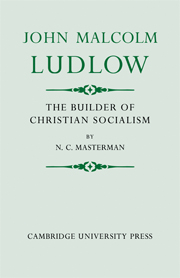Book contents
- Frontmatter
- Contents
- Acknowledgements
- INTRODUCTION
- I THE PARISIAN SCHOOLBOY
- II THE STRANGE YOUNG LAWYER
- III THE FRATERNAL CHRISTIAN
- IV FRENCH SOCIALISM FOR ENGLISH CHARTISTS
- V THE STATESMAN OF CO-OPERATION
- VI THE PRODUCER'S THEORETICIAN
- VII A PROPHET OUT-PROPHESIED?
- VIII REVIEWER AND EDUCATIONALIST
- IX THE DEMOCRATIC IMPERIALIST
- X THE MENTOR OF GERMANS
- XI LEGISLATOR AND CIVIL SERVANT
- XII THE CRITICAL UNIONIST
- Conclusion: LUDLOW'S ACHIEVEMENT
- Appendix: LUDLOW ON THE JUNTA
- Notes
- Bibliography
- Index
Conclusion: LUDLOW'S ACHIEVEMENT
Published online by Cambridge University Press: 07 October 2011
- Frontmatter
- Contents
- Acknowledgements
- INTRODUCTION
- I THE PARISIAN SCHOOLBOY
- II THE STRANGE YOUNG LAWYER
- III THE FRATERNAL CHRISTIAN
- IV FRENCH SOCIALISM FOR ENGLISH CHARTISTS
- V THE STATESMAN OF CO-OPERATION
- VI THE PRODUCER'S THEORETICIAN
- VII A PROPHET OUT-PROPHESIED?
- VIII REVIEWER AND EDUCATIONALIST
- IX THE DEMOCRATIC IMPERIALIST
- X THE MENTOR OF GERMANS
- XI LEGISLATOR AND CIVIL SERVANT
- XII THE CRITICAL UNIONIST
- Conclusion: LUDLOW'S ACHIEVEMENT
- Appendix: LUDLOW ON THE JUNTA
- Notes
- Bibliography
- Index
Summary
‘He was a small, bent, active man’, wrote Canon Tissington Tatlow, who knew Ludlow as an old man in 1902–3, ‘with a long brown beard turning grey. I remember him especially for his eyes, sparkling, twinkling eyes, which lit up the whole of his face as he talked. He used to sit on the ottoman with his hands, palms together, between his knees, and rock himself slightly backwards and forwards as he poured out in his lively manner his reminiscences, especially of F. D. Maurice and [Bishop] Westcott.’
Again, Canon Guy Rogers wrote of him, ‘I only met Ludlow once, but I have never forgotten it. I was received with such courtesy by this distinguished old gentleman; perhaps being a curate made me all the more sensitive to his graciousness. With an absolutely fascinating modesty he showed me some pictures of the Rochdale pioneers, which hung in his hall, and we had a few words together about their history, that was all.
These two personal reminiscences illustrate Ludlow's dual role. As the founder of the Christian Socialist Movement of 1848–54 he linked together some clergy and laity of the Church of England with the working class co-operative movement, then inspired by the teaching of Robert Owen and his followers. Purposely avoiding the limelight, as the hidden central figure of a closely-knit group, he achieved something more.
- Type
- Chapter
- Information
- John Malcolm LudlowThe Builder of Christian Socialism, pp. 257 - 263Publisher: Cambridge University PressPrint publication year: 1963



